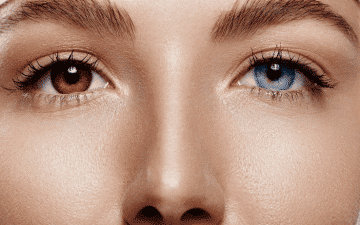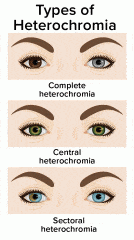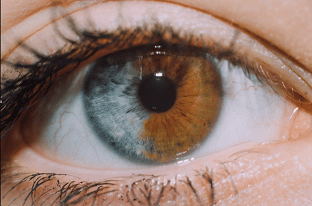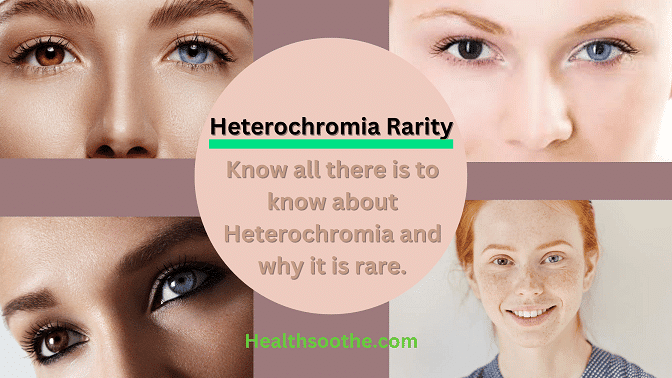What do Mila Kunis, Christopher Walken, and Alexander the Great have in common? Aside from being well-known figures to many people across the world, all three of them also have an eye condition known as Heterochromia or two different colored eyes.
Quick Facts About Heterochromia
| A | B |
|---|---|
| Definition | Heterochromia is a condition where a person has eyes of two different colors, or variations within one or both eye |
| Types | Complete Heterochromia: Each eye is a completely different color; Sectoral Heterochromia: Part of one iris is a different color from its remainder; Central Heterochromia: An inner ring is a different color than the rest of the iris |
| Causes | Can be due to genetic mutations, congenital or acquired conditions, eye injury, or certain eye drops |
| Symptoms | Usually just the difference in eye color; May be accompanied by other symptoms if caused by a medical condition |
| Prevalence | It's relatively rare in humans, occurring in less than 1% of the population but common in certain animals like dogs, cats, and horses |
| Eye Color Determination | Influenced by genetics and the amount and distribution of melanin in the irises |
| Eye Color Change | Possible in infancy as melanin develops, but rare after the first year |
| Health Impact | Heterochromia is typically harmless and doesn't affect vision. However, it can sometimes be associated with underlying health conditions. |
| Treatment | Treatment is usually unnecessary unless it's caused by an underlying condition that needs medical attention. Cosmetic contact lenses are an option for people who want to change the appearance |
| Famous Cases | Famous individuals with heterochromia include David Bowie, Kate Bosworth, and Mila Kunis |
Heterochromia is fairly uncommon, occurring in less than 1 percent of the population. It can be caused by several factors and present itself in different ways.
Today’s article - Heterochromia Rarity aims to expatiate all there is to know about heterochromia, and its rarity - Heterochromia Rarity. So, in case, you are among those who were wondering about heterochromia rarity, then you are reading the right article.
Alright, we move.
What do you know about Heterochromia?

Heterochromia is a variation in coloration. The term is most often used to describe color differences of the iris, but can also be applied to color variation of hair or skin.
Heterochromia is determined by the production, delivery, and concentration of melanin (a pigment). It may be inherited, or caused by genetic mosaicism 1https://en.wikipedia.org/wiki/Mosaicism, chimerism, disease, or injury. It occurs in humans and certain breeds of domesticated animals.
Heterochromia of the eye is called heterochromia iridum or heterochromia iridis 2"heterochromia iridis - definition of heterochromia iridis in the Medical dictionary - by the Free Online Medical Dictionary, Thesaurus and Encyclopedia". Medical-dictionary.thefreedictionary.com. Retrieved 2014-04-27. . It can be complete or sectoral. In complete heterochromia, one iris is a different color from the other.
In sectoral heterochromia, part of one iris is a different color from its remainder. In central heterochromia, there is a ring around the pupil or possibly spikes of different colors radiating from the pupil.
Though multiple causes have been posited, the scientific consensus is that a lack of genetic diversity 3Konovalova EN, Gladyr EA, Kostiunina OV, Zinovieva LK (2017). "Congenital Defects of Beef Cattle and General Principles of their Prevention". Journal of Agriculture and Environment. 2 (3).doi:10.23649/jae.2017.2.3.1. 4 Ur Rehman H (2008). "Heterochromia". CMAJ. 179 (5): 447–448. doi:10.1503/cmaj.070497. PMC 2518194. PMID 18725617.is the primary reason behind heterochromia, at least in domestic animals.
This is due to a mutation of the genes that determine melanin distribution at the 8-HTP pathway, which usually only become corrupted due to chromosomal homogeneity.
Though common in some breeds of cats, dogs, cattle, and horses due to inbreeding, heterochromia is uncommon in humans, affecting fewer than 200,000 people in the United States, and is not associated with a lack of genetic diversity.
The affected eye may be hyperpigmented (hyperchromic) or hypopigmented (hypochromic). In humans, an increase in melanin production in the eyes indicates hyperplasia of the iris tissues, whereas a lack of melanin indicates hypoplasia.
Classification or Types of Heterochromia

Heterochromia is classified primarily by onset: as either genetic or acquired.
Although a distinction is frequently made between heterochromia that affects an eye completely or only partially (sectoral heterochromia), it is often classified as either genetic (due to mosaicism or congenital) or acquired, with mention as to whether the affected iris or portion of the iris is darker or lighter.
Most cases of heterochromia are hereditary or caused by genetic factors such as chimerism, and are entirely benign and unconnected to any pathology, however, some are associated with certain diseases and syndromes. Sometimes one eye may change color following disease or injury.
The classifications are as follows;
Genetic
Abnormal iris darker
- Lisch nodules – iris hamartomas seen in neurofibromatosis.
- Ocular melanosis – a condition characterized by increased pigmentation of the uveal tract, episclera, and anterior chamber angle.
- Oculodermal melanocytosis (nevus of Ota)
- Pigment dispersion syndrome – a condition characterized by loss of pigmentation from the posterior iris surface which is disseminated intraocularly and deposited on various intraocular structures, including the anterior surface of the iris.
- Sturge–Weber syndrome – a syndrome characterized by a port-wine stain nevus in the distribution of the trigeminal nerve, ipsilateral leptomeningeal angiomas with intracranial calcification and neurologic signs, and angioma of the choroid, often with secondary glaucoma.
Abnormal iris lighter
- Simple heterochromia – a rare condition characterized by the absence of other ocular or systemic problems. The lighter eye is typically regarded as the affected eye as it usually shows iris hypoplasia. It may affect an iris completely or only partially.
- Congenital Horner's syndrome – sometimes inherited, although usually acquired.
- Waardenburg syndrome – a syndrome in which heterochromia is expressed as a bilateral iris hypochromia in some cases. A Japanese review of 11 children with albinism found that the condition was present. All had sectoral/partial heterochromia.
- Piebaldism – similar to Waardenburg's syndrome, a rare disorder of melanocyte development characterized by a white forelock and multiple symmetrical hypopigmented or depigmented macules.
- Hirschsprung's disease – a bowel disorder associated with heterochromia in the form of a sector hypochromia. The affected sectors have been shown to have reduced numbers of melanocytes and decreased stromal pigmentation.
- Incontinentia pigmenti
- Parry–Romberg syndrome
Acquired
Heterochromia is usually due to injury, inflammation, the use of certain eye drops that damage the iris, or tumors.
Abnormal iris darker
- Deposition of material:
- Siderosis – iron deposition within ocular tissues due to a penetrating injury and a retained iron-containing, intraocular foreign body.
- Hemosiderosis – long-standing hyphema (blood in the anterior chamber) following blunt trauma to the eye may lead to iron deposition from blood products.
- Certain eye drops – prostaglandin analogues (latanoprost, isopropyl unoprostone, travoprost, and bimatoprost) are used topically to lower intraocular pressure in glaucoma patients. A concentric heterochromia has developed in some patients applying these drugs. The stroma around the iris sphincter muscle becomes darker than the peripheral stroma. A stimulation of melanin synthesis within iris melanocytes has been postulated.
- Neoplasm – Nevi and melanomatous tumors.
- Iridocorneal endothelial syndrome
- Iris ectropion syndrome
Abnormal iris lighter
- Fuchs heterochromic iridocyclitis – a condition characterized by a low grade, asymptomatic uveitis in which the iris in the affected eye becomes hypochromic and has a washed-out, somewhat moth-eaten appearance. The heterochromia can be very subtle, especially in patients with lighter-colored irides. It is often most easily seen in daylight. The prevalence of heterochromia associated with Fuchs has been estimated in various studies with results suggesting that there is more difficulty recognizing iris color changes in dark-eyed individuals.
- Acquired Horner's syndrome – usually acquired, as in neuroblastoma, although sometimes inherited.
- Neoplasm – Melanomas can also be very lightly pigmented, and a lighter-colored iris may be a rare manifestation of metastatic disease to the eye.
- Parry–Romberg syndrome – due to tissue loss.
- Heterochromia has also been observed in those with Duane syndrome.
- Chronic iritis
- Juvenile xanthogranuloma
- Leukemia and lymphoma
Partial Heterochromia – Different Colors in the Same Iris

Partial heterochromia is most often a benign trait of genetic origins, but, like complete heterochromia, can be acquired or be related to clinical syndromes.

- Sectoral: In sectoral heterochromia, areas of the same iris contain two different colors, the contrasting colors being demarcated in a radial, or sectoral, manner. Sectoral heterochromia may affect one or both eyes. It is unknown how rare sectoral heterochromia is in humans, but it is considered to be less common than complete heterochromia.

- Central: Central heterochromia is also an eye condition where there are two colors in the same iris; but the arrangement is concentric, rather than sectoral. The central (pupillary) zone of the iris is a different color than the mid-peripheral (ciliary) zone. Central heterochromia is more noticeable in irises containing low amounts of melanin.
What causes Heterochromia?
The color of our eyes comes from the appearance of the pigment that is present in the iris, the central part of the eye. Brown eyes are rich in melanin pigment deposits, making them darker, while blue eyes lack melanin.
Heterochromia happens when the concentration and distribution of melanin aren't uniform. While the condition is often genetic, it can also be caused by injuries - such as a punch leading to bleeding with the eye - inflammation, or glaucoma.
There are many types and causes of heterochromia. An infant can be born with heterochromia or develop heterochromia soon after birth. In these cases, it is called congenital heterochromia.
In most cases, children born with heterochromia will experience no other symptoms. They do not have any other problems with their eyes or general health. However, in some cases, heterochromia can be a symptom of another condition.
Most cases of heterochromia iridis occur sporadically in people with no family history of the condition. However, heterochromia iridis is rarely part of an inherited genetic syndrome.
For example, heterochromia iridis is reported in some people affected by Waardenburg syndrome which is generally inherited in an autosomal dominant manner). Sometimes, one eye may change color following certain diseases or injuries.
Causes of heterochromia in infants can include:
- Horner’s syndrome
- Benign heterochromia
- Sturge-Weber syndrome
- Waardenburg syndrome
- Piebaldism
- Hirschsprung disease
- Bloch-Sulzberger syndrome
- von Recklinghausen disease
- Bourneville disease
- Parry-Romberg syndrome
- Familial heterochromia
When a person gets heterochromia later in life, this is called acquired heterochromia.
Causes of acquired heterochromia include:
- Acquired Horner’s syndrome
- Benign and malignant tumors of the iris
- Bleeding (hemorrhage) in the eye
- Central retinal vein occlusion
- Chediak-Higashi syndrome
- Diabetes mellitus
- Eye injury
- Eye surgery
- Foreign object in the eye
- Fuchs’ heterochromic cyclitis
- Glaucoma and some medications used to treat it
- Iris ectropion syndrome
- Latisse, a repurposed glaucoma medication used cosmetically to thicken eyelashes
- Mild inflammation affecting only one eye
- Neurofibromatosis
- Ocular melanosis
- Pigment dispersion syndrome
- Posner-Schlossman syndrome
- Swelling, due to iritis or uveitis
Heterochromia Rarity – Why is heterochromia rare?
Heterochromia is fairly uncommon, occurring in less than 1 percent of the population. Regardless of the type, all heterochromia is extremely rare 5https://www.allaboutvision.com/conditions/rare-heterochromia/, according to All About Vision.
In fact, complete heterochromia only affects six out of every 10,000 people. This means that less than 200,000 Americans have two different colored eyes. Fewer than 1% of people have any form of heterochromia 6https://www.medicalnewstoday.com/articles/eye-color-percentage, perMedical News Today.
As to why Heterochromia is that rare, the cause is not known, as it doesn’t have a definitive or constant pattern of occurrence as it can occur sporadically in certain generations without indications.
Most cases of heterochromia iridis occur sporadically in people with no family history of the condition. However, heterochromia iridis is rarely part of an inherited genetic syndrome.
For example, heterochromia iridis is reported in some people affected by Waardenburg syndrome which is generally inherited in an autosomal dominant manner). Sometimes, one eye may change color following certain diseases or injuries.
Heterochromia Diagnosis and Treatment
If your infant has heterochromia, he or she should be examined by an ophthalmologist. The ophthalmologist will confirm the appearance of heterochromia and look for any underlying causes.
In most cases, there will be no concerning disease or condition causing the eye color variation. However, it is important to rule out these conditions.
If you get heterochromia as an adult or it changes in appearance, see your ophthalmologist. He or she can perform a detailed eye exam to rule out any underlying causes and come up with a treatment plan if necessary.
Treatment for heterochromia focuses on treating any underlying causes of the condition. If there are no other issues with the eyes, no treatment may be needed.
Is Heterochromia a Cause for Concern?
Abnormalities in eye color are not necessarily a sign of an underlying health problem, but it can be a component of a few inherited genetic disorders. One example is Waardenburg Syndrome, which causes children to experience hearing loss, premature graying hair, and degrees of Heterochromia.
Another example is neurofibromatosis, which affects the nervous system and causes tumors to form on nerve tissue. Tumor formation inside the eye can cause Heterochromia.
If Heterochromia occurs suddenly, it could be a sign of an underlying medical condition. A comprehensive eye examination with your eye doctor can rule out any serious issues.
All right, guys, that is it for now for heterochromia rarity. I hope Healthsoothe answered any questions you had concerning heterochromia rarity.
Feel free to contact us at contact@healthsoothe.com if you have further questions to ask or if there’s anything you want to contribute or correct to this article. And don’t worry, Healthsoothe doesn’t bite.
You can always check our FAQs section below to know more about heterochromia rarity.
And always remember that Healthsoothe is one of the best health sites out there that genuinely cares for you.
Frequently Asked Questions related to Heterochromia Rarity
How Rare is a Black Eye?
This condition is seen in less than 1 percent of people, but it's frequently seen in dogs. It can be the result of heredity problems during eye development.
Is Partial Heterochromia Rare?
The incidence of congenital heterochromia iridis is approximately six out of 1,000, although, in most of these cases, it is hardly noticeable and unassociated with any other abnormality.
How Rare is Total or Complete Heterochromia?
Heterochromia — in which a person has more than one eye color — affects less than 1% of people. The two eyes might be completely different from one another, or one part of the iris might be different than the rest.
What are the Rarest Heterochromia Colors?
Additional resources and citations
- 1https://en.wikipedia.org/wiki/Mosaicism
- 2"heterochromia iridis - definition of heterochromia iridis in the Medical dictionary - by the Free Online Medical Dictionary, Thesaurus and Encyclopedia". Medical-dictionary.thefreedictionary.com. Retrieved 2014-04-27.
- 3Konovalova EN, Gladyr EA, Kostiunina OV, Zinovieva LK (2017). "Congenital Defects of Beef Cattle and General Principles of their Prevention". Journal of Agriculture and Environment. 2 (3).doi:10.23649/jae.2017.2.3.1.
- 4Ur Rehman H (2008). "Heterochromia". CMAJ. 179 (5): 447–448. doi:10.1503/cmaj.070497. PMC 2518194. PMID 18725617.
- 5https://www.allaboutvision.com/conditions/rare-heterochromia/
- 6https://www.medicalnewstoday.com/articles/eye-color-percentage
The content is intended to augment, not replace, information provided by your clinician. It is not intended nor implied to be a substitute for professional medical advice. Reading this information does not create or replace a doctor-patient relationship or consultation. If required, please contact your doctor or other health care provider to assist you to interpret any of this information, or in applying the information to your individual needs.

